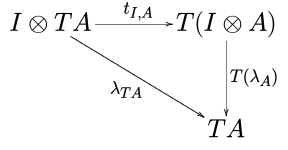Strong monad
In category theory, a strong monad over a monoidal category (C, ⊗, I) is a monad (T, η, μ) together with a natural transformation tA,B : A ⊗ TB → T(A ⊗ B), called (tensorial) strength, such that the diagrams




commute for every object A, B and C (see Definition 3.2 in [1]).
If the monoidal category (C, ⊗, I) is closed then a strong monad is the same thing as a C-enriched monad.
Commutative strong monads
For every strong monad T on a symmetric monoidal category, a costrength natural transformation can be defined by
- .
A strong monad T is said to be commutative when the diagram
commutes for all objects and .[2]
One interesting fact about commutative strong monads is that they are "the same as" symmetric monoidal monads. More explicitly,
- a commutative strong monad defines a symmetric monoidal monad by
- and conversely a symmetric monoidal monad defines a commutative strong monad by
and the conversion between one and the other presentation is bijective.
References
- Moggi, Eugenio (July 1991). "Notions of computation and monads" (PDF). Information and Computation. 93 (1): 55–92. doi:10.1016/0890-5401(91)90052-4.
- (ed.), Anca Muscholl (2014). Foundations of software science and computation structures : 17th (Aufl. 2014 ed.). [S.l.]: Springer. pp. 426–440. ISBN 978-3-642-54829-1.CS1 maint: extra text: authors list (link)
- Anders Kock (1972). "Strong functors and monoidal monads" (PDF). Archiv der Mathematik. 23: 113–120. doi:10.1007/BF01304852.
- Jean Goubault-Larrecq, Slawomir Lasota and David Nowak (2005). "Logical Relations for Monadic Types". Mathematical Structures in Computer Science. 18 (06): 1169. arXiv:cs/0511006. doi:10.1017/S0960129508007172.
